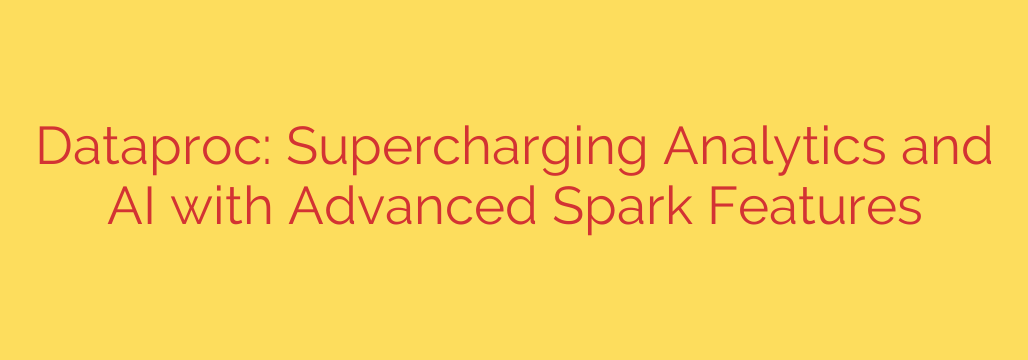
Mastering Big Data: A Guide to Advanced Spark Features in Dataproc
In the world of big data, Apache Spark is a powerhouse. But running Spark efficiently at scale presents its own set of challenges, from managing complex infrastructure to controlling runaway costs. This is where a managed service like Google Cloud’s Dataproc shines, not just by simplifying Spark deployments, but by layering on advanced features that unlock unprecedented levels of performance, efficiency, and security.
If you’re looking to move beyond basic Spark jobs and truly supercharge your analytics and AI pipelines, understanding these advanced capabilities is essential. Let’s explore the key features that transform Dataproc from a simple managed service into a sophisticated data processing platform.
Fine-Tuning Performance with Intelligent Autoscaling
One of the biggest drains on a data budget is the static, over-provisioned cluster. Teams often create large clusters to handle peak loads, but these resources sit idle—and cost money—during off-peak times.
Dataproc tackles this head-on with enhanced autoscaling policies. These policies go beyond simple scaling by allowing for highly granular control over how your clusters grow and shrink. You can define separate policies for primary and secondary workers, set cooldown periods to prevent frantic scaling, and base decisions on multiple metrics like CPU and memory utilization.
The result is a cluster that intelligently adapts to your workload in real-time. This ensures you have the power you need for demanding jobs while dramatically reducing costs by releasing unused resources automatically. It’s the key to achieving optimal resource utilization and performance stability without manual intervention.
Unify Your Data Stack: Deep Integration with Google Cloud
A data processing engine is only as powerful as the ecosystem it connects to. Dataproc is deeply woven into the fabric of Google Cloud, creating a seamless and powerful environment for end-to-end data workflows.
- Google Cloud Storage (GCS): By decoupling storage and compute, you can store massive datasets affordably in GCS and spin up Dataproc clusters only when you need to process data.
- BigQuery: Dataproc features a built-in connector that makes reading from and writing to BigQuery incredibly fast and simple. This allows you to use Spark for complex transformations and then load the results into BigQuery for high-speed, interactive analytics.
- Vertex AI: For machine learning teams, the integration with Vertex AI is a game-changer. You can use Dataproc to perform large-scale data preparation and feature engineering, then seamlessly use that data to train models in Vertex AI, creating a powerful and accelerated AI/ML workflow.
This native integration allows you to build a truly unified data platform where data flows effortlessly between processing, storage, analytics, and machine learning services.
Demystifying Job Failures with the Persistent History Server
Anyone who has worked with ephemeral clusters knows the frustration of a job failing after the cluster has already been shut down. The logs, error messages, and performance metrics—all critical for debugging—are gone forever.
The Dataproc Persistent History Server (PHS) solves this critical problem. By creating a standalone, long-running server, Dataproc stores the Spark event logs from all your jobs, even after their clusters have been deleted. This provides an invaluable, centralized location for long-term debugging and performance analysis. Developers and operations teams can go back in time to investigate failures, identify performance bottlenecks, and perform detailed root cause analysis without needing to keep costly clusters running.
Embrace Effortless Scalability with Dataproc Serverless for Spark
For many teams, the ultimate goal is to focus on business logic, not infrastructure. Managing clusters, even with autoscaling, still involves a degree of operational overhead. Dataproc Serverless for Spark represents the next evolution in data processing.
With Dataproc Serverless, you simply submit your Spark code and Google Cloud handles the rest. There are no clusters to provision, manage, or scale. The platform automatically allocates the necessary resources to run your job and releases them the moment it’s finished.
This approach is ideal for intermittent or unpredictable workloads, offering significant benefits:
- Zero infrastructure management: Your team can focus on writing code, not configuring clusters.
- Cost-effective: You only pay for the exact resources consumed during your job’s execution, following a true pay-per-use model.
- Rapid development: It dramatically speeds up the development lifecycle, as there is no waiting for cluster provisioning.
Fortifying Your Data with Enhanced Security and Governance
In an enterprise environment, security isn’t an afterthought—it’s a requirement. Dataproc integrates with Google Cloud’s robust security features to ensure your data pipelines are protected.
Key security measures you can implement include:
- Fine-grained IAM Roles: Go beyond basic permissions and grant users the exact access they need to submit jobs or manage clusters, adhering to the principle of least privilege.
- VPC Service Controls: Create a service perimeter around your Dataproc and other Google Cloud services to prevent data exfiltration and ensure that sensitive data does not leave your trusted network boundary.
- Customer-Managed Encryption Keys (CMEK): For organizations with strict compliance requirements, you can use your own encryption keys to protect data at rest within your Dataproc environment, giving you full control over data security.
By leveraging these features, you can build data processing pipelines that are not only powerful and efficient but also meet the most stringent enterprise security and governance standards.
Source: https://cloud.google.com/blog/products/data-analytics/why-use-dataproc-for-your-apache-spark-environment/








